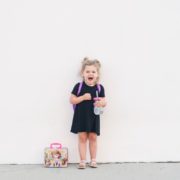Comparing Preschool Philosophies: Finding The Right Program For Your Child
Preschool, did I just really say that? Is my baby going to actual school, with classmates, teachers and leavinggggggg meeee? She is my first born ya know, I may cry a little watching her march into the classroom for the first day and become even more independent. You know what else made me cry a little? The list of 15 preschools that I applied to, set up tours with and basically stalked. I mean when did preschools get waiting lists? When I grew up (I just totally aged myself there), you went to the preschool in your church, or whatever was down the street, just simple and easy. I think my Mom was happy I learned my ABC’s, 123’s, and colors. Nowadays there are quite a few different philosophies including Motessori, Waldorf, Progressive, Traditional, and Reggio Emilia to name a few! Feeling flustered yet? Well that’s where I come in! I wanted to make The Chic Mamas a place where parents can come to find easy and simple information on how to choose the right preschool program for your family! I know it feels like a big task, so let me help break down each philosophy for you below to make it a little easier on you.
- The Montessori Method
- This is a child-centered approach in which the child’s play is considered their work and they learn at their own pace. Teachers serve as a guide to help foster independence, self-esteem and confidence in each child. Classes have mixed age groups that encourage older children to help younger children learn. Materials in the classroom are called “manipulatives” which are based in three different learning groups: practical life skills, sensory skills, and language/mathematical skills. Think puzzles, or a ribbon tying station for example, each material allows the child to determine if he or she has done the exercise correctly. A teacher doesn’t correct a child’s work, rather they are encouraged to try again, ask the teacher for suggestions or ask another child for help.
- The Waldorf Approach
- This approach aims to educated the whole child, “head, hands and heart”. There is an emphasis on creative and imaginative play with a focus on teamwork and community. With the Waldorf approach, what may seem like extracurricular activities in other schools are the main learning tools in this setting with hands on play including art, gardening, puppetry, cooking, dress up, foreign languages, singing, etc. Teachers must be certified and aim to enable students to choose and realize their path in life. The Waldorf classroom will look and feel “homey” with natural materials such as different textured cloths for dress-up, wooden blocks for building, kitchen utensils, musical instruments, etc.
- Progressive or The Bank Street Model
- This model is child-centered in which the child is a planner, participant and problem solver. Usually there is no pre-planned curriculum, and the teacher follows the child’s lead in areas of interest where they encourage children to pursue their own projects. Children learn and explore through art, imaginative play, block building, etc. Every child is acknowledged as an individual that each have different needs. A classroom may be set up with “stations” different materials to foster the child’s imaginative play.
- Traditional Method
- This method is very structured and formal. It is teacher-led with a pre-set curriculum. The teacher drives each lesson by explaining and directing, while the child learns from listening and absorbing the information, rather than exploration. Goals of the curriculum are built around teaching letters, numbers, sounds, problem solving, shapes, math and listening. In this setting, classrooms may be set up with desks for each child.
- The Reggio Emilia Approach
- This multi-sensory approach focuses on providing opportunities for problem solving through creative thinking and exploration. The teacher puts a great deal of energy into the detail of the classroom. The classroom is looked at as an educator, and is made to be inviting and stimulating. You may find different areas dedicated to art, exploration with natural materials like sand or water, science and building, dramatic play, math or writing. In this setting children are invited to explore and problem solve. The teacher observes each child to see an area of interest and then acts as a guide by asking the child questions helping them to discover hypotheses, ideas and theories.
You may find that many schools take a part of each philosophy to build a blended learning environment as well. I hope that you can use these tips on each philosophy to go into any tour or preschool setting feeling knowledgeable and aimed with information to help narrow down your choices. I found that understanding each philosophy helped me stay focused when choosing preschools to tour. Later this month I will also be sharing the most important questions to ask on a tour and my downloadable spreadsheet to help you stay organized with all of this craziness! Let me know which method you prefer and works for your family in the comments below!
XOXO,
Abby


